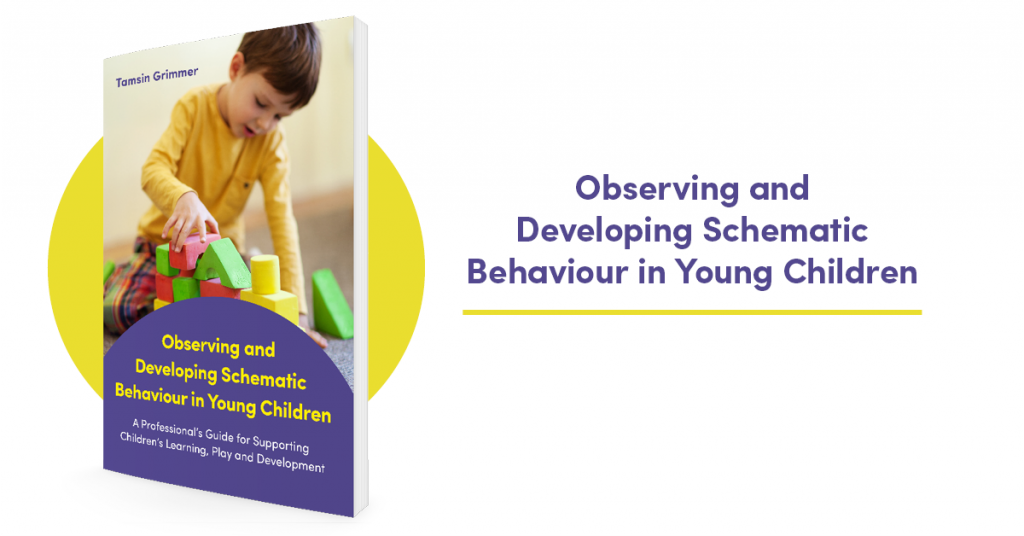Tamsin Grimmer, author of Observing and Developing Schematic Behaviour in Young Children, describes the 12 common types of schematic behaviour in young children, and how recognising and adapting these schemas can aid their learning, development and play.
Have your ever noticed a child lining up their toys or spinning around in circles? Or that a child is often more interested in a cardboard box, rather than the gift that was in it? Perhaps you are perplexed by the toddler who repeatedly throws their cup from their high chair?
Children do many puzzling things and will often repeat these behaviours. It is highly likely that these behaviours are schematic. In my new book, Observing and Developing Schematic Behaviour in Young Children, I unpick the most common schemas and provide ideas of how to extend children’s learning based on their schematic interests. I also consider children whose behaviour may be misinterpreted as challenging when it could simply be schematic.
When looking at schema theory, I have stripped back the technical language that is often used to describe schemas, and instead focus on interpreting observations of children who are engaged in schematic play.
I consider the following 12 common schemas, listed here with some examples:
- Connecting – joining and connecting toys together
- Containing – filling and emptying boxes and bags
- Core and radial – creating shapes which involve circles and lines
- Enclosing – climbing into boxes or fencing in their toys
- Enveloping – hiding under blankets and covering themselves up
- Going through a boundary – playing with doors, windows or going through play tunnels
- Orientation – lying upside down or looking through their legs
- Positioning – lining up toys or sorting objects by size, colour or shape
- Rotation – spinning and rolling toys or themselves
- Trajectory – throwing things or dropping toys
- Transforming – mixing food together or mixing sand and water
- Transporting – moving toys around in buggies, trolleys or pushchairs
For each of these schemas, I include case studies, interpret the observations and share practical ideas for how to use this information to extend each schema and aid children’s learning, development and play.
Three year old Katie loaded up the pushchair with several bags at once and moved around the nursery. She was containing and enjoyed the process of putting things in the various bags that she hung on the pushchair. Katie was investigating concepts relating to volume and capacity. How much will fit in this bag? Will this toy squeeze into that backpack? These ideas will also support her in her developing understanding of spatial awareness and size.
Carlos lined up the cars side by side on the car mat. He was very purposeful and methodical about where he placed each car and showed little interest in ‘driving’ the cars around. This is evidence of a positioning schema. Each car needed its own space and Carlos was paying attention to detail in his play. A practitioner working with Carlos extended his interest in positioning cars by building a garage with him out of a shoe box, so that Carlos could place each car in a parking space.
In my chapter about reinterpreting behaviour in the light of schemas, we meet several children whose behaviour could be viewed as challenging. For example, Jack, who likes to knock down other children’s towers. I suggest that schemas provide a new lens with which to view these children and in doing so redirect them into more worthwhile endeavours.
It would be easy to become concerned about the destructive nature of Jack’s play, however, Jack could be investigating disconnecting, which links with the connection schema, and also enjoying the trajectory movement involved with knocking down the towers. With this is mind, we can play alongside Jack building towers specifically for him to knock down and encourage him to play stacking games such as Jenga. We could redirect Jack’s attention into activities involving trajectory movement or connecting and disconnecting which might capture his attention. We can also work alongside Jack to help him to understand how the action of knocking down a tower impacts on the other children. Using schemas to reinterpret children’s challenging behaviour gives us, as practitioners, another tool for our toolbox.
If you want to find out more about schematic behaviour and how you can further support children’s learning, development and play then this book is for you.
If you would like to read more articles like Tamsin’s and get the latest news and offers on our Early books, why not join our mailing list? We can send information by email or post as you prefer. You may also be interested in liking our Special Education, PSHE and Early Years Resources Facebook page.

One thought